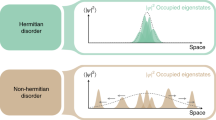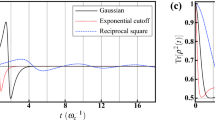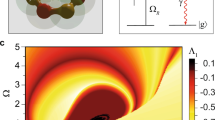Abstract
Noise is generally thought as detrimental for energy transport in coupled oscillator networks. However, it has been shown that for certain coherently evolving systems, the presence of noise can enhance, somehow unexpectedly, their transport efficiency; a phenomenon called environment-assisted quantum transport (ENAQT) or dephasing-assisted transport. Here, we report on the experimental observation of such effect in a network of coupled electrical oscillators. We demonstrate that by introducing stochastic fluctuations in one of the couplings of the network, a relative enhancement in the energy transport efficiency of 22.5 ± 3.6% can be observed.
Similar content being viewed by others
Introduction
Transport phenomena are ubiquitous throughout different fields of research. Some of the most common examples of transport analysis are seen in the fields of physics, chemistry and biology1. In recent years, energy transport assisted by noise2,3,4 has attracted a great deal of attention, partly because of its potential role in the development of future artificial light-harvesting technologies5,6,7. This intriguing phenomenon has theoretically been shown to occur in several quantum8,9,10,11,12,13,14 and classical15,16,17,18 systems; however, efforts towards its experimental observation had not been presented until very recently. Viciani et al.19 showed an enhancement in the energy transport of optical fiber cavity networks, where the effect of noise on the system was introduced by averaging the optical response of several network configurations with different cavity-frequency values. In a closely related experiment, Biggerstaff et al.20 demonstrated an increase in the transport efficiency of a laser-written waveguide network, where decoherence effects were simulated by averaging the output signal of the waveguide array considering different illumination wavelengths. Using the same photonic platform, Caruso et al.21 observed an enhanced transport efficiency when suppressing interference effects in the transport dynamics of a photonic network. In this experiment, noise was implemented by dynamically modulating the propagation constants of the waveguides, which is the natural way for producing decohering noise, as it has been experimentally demonstrated in the context of quantum random walks22,23,24.
In this work, we report on the observation of noise-assisted energy transport in a network of capacitively coupled RLC oscillators, where R stands for resistance, L for inductance and C for capacitance. Although in previous studies of ENAQT noise has been modeled as fluctuations in the frequency of each oscillator, so-called diagonal fluctuations2, here we introduce noise in the system by means of stochastic fluctuations in one of the network’s capacitive couplings, referred to as off-diagonal dynamical disorder25. Using this system, we show that fluctuations in the coupling can indeed influence the system so that the energy transferred to one of the oscillators is increased, demonstrating that off-diagonal dynamical disorder can effectively be used for enhancing the efficiency of energy transport systems.
Results
We consider a network of three identical RLC oscillators (as shown in Fig. 1), whose dynamics are described by
Schematic representation of the experiment and typical dynamic interaction response.
(a) Schematic of the network of three capacitively coupled RLC electrical oscillators. (b) Typical averaged voltage signals measured in each oscillator. (c) Sample of a typical noise signal, Vs, introduced in the capacitive coupling between the first and second oscillator.


where Vn is the voltage in each oscillator, in is the current and Cnm represents the capacitive couplings.
Noise is introduced in the system by inducing random fluctuations in one of the capacitive couplings, so that

with C12 being the average capacitance of the coupling and ϕ(t) a Gaussian random variable with zero average, i.e.  , where
, where  denotes stochastic averaging.
denotes stochastic averaging.
Previous studies of noise-assisted transport have shown that efficiency enhancement can be observed by measuring the energy that is irreversibly dissipated in one particular site of the network, the so-called sink or reaction center3,8,14,17. Here, we take the resistance in Oscillator-2 to be the sink and measure the relative energy that is dissipated through it by computing

where  is the total energy dissipated by all the oscillators. Notice that Eq. (4) is equivalent to the efficiency measure that was derived in a previous work on noise-assisted transport in classical oscillator systems17.
is the total energy dissipated by all the oscillators. Notice that Eq. (4) is equivalent to the efficiency measure that was derived in a previous work on noise-assisted transport in classical oscillator systems17.
We have experimentally implemented the system described by Eqs. (1, 2, 3) using functional blocks synthesized with operational amplifiers and passive linear electrical components (see Methods and accompanying Supplementary Information). Our experimental setup was designed so that the frequencies of each oscillator were the same (v = 290.57 Hz), as well as the couplings between them (Cnm = 40 μF). Notwithstanding, based on our measurements, we found that the designed system was characterized by the following parameters: ν = 283.57 Hz, C12 = 39 μF, C13 = 41.7 μF and C23 = 39 μF. These variations in the parameters of the system result from the tolerances (around 5%) of all the electronic components used in the implementation of the circuit.
As described in the methods section, noise was introduced in one of the network’s capacitive couplings using a random signal provided by a function generator (Diligent Analog Discovery 410-244P-KIT). The electronic circuit was designed so the voltage of the noise signal, Vs, is directly map into Eq. (3), thus making the stochastic variable ϕ(t) fluctuate within the interval (−Vs, +Vs), with a 1 kHz frequency. Notice that the frequency of the noise signal is higher than the oscillators’ natural frequency, which guarantees a true dynamical variation of the capacitive coupling. Figure 2 shows some examples of the histograms of noise signals extracted directly from the function generator.
Histograms of noise signals extracted directly from the arbitrary function generator using different values of noise voltage: (a) Vs = 200 mV, (b) Vs = 400 mV, (c) Vs = 600 mV and (d) Vs = 800 mV. Samples were obtained from noise signals with frequency of 1 kHz, within a 1 s time-window. Number of events is defined as the number of samples that have the same voltage.
Using the configuration described above, we measured the energy dissipated through the resistor in Oscillator-2 [Eq. (4)] as a function of the noise voltage introduced in the capacitive coupling. We can see from Fig. 3 that transport efficiency in Oscillator-2 is enhanced as the noise voltage increases, a sign of noise-assisted energy transport17. We obtained an enhancement of 22.50 ± 3.59% for a maximum noise voltage of 850 mV. It is important to remark that we cannot go beyond this value using the present configuration because, when introducing noise signals close to 1 volt (or more), the system becomes unstable due to the presence of negative capacitances in the coupling [see Eq. (3)]. However, as obtained in our numerical simulations, a higher efficiency may be reached by incorporating random fluctuations in the remaining couplings.
Transport efficiency measured in Oscillator-2 as a function of the noise voltage.
Experimental results (dotted line) were obtained by averaging the oscillator’s signal over 500 stochastic realizations. The solid line represents the theoretical calculation of transport enhancement using the noise signal extracted directly from the arbitrary function generator. The shaded region represents transport enhancement when noise introduced in the capacitive coupling deviates from the value provided by the function generator by up to 10%. Transport efficiencies of all oscillators are plotted in the inset. Notice that the effect of noise is to rearrange the energy available in the system in order to increase the efficiency of Oscillator-2. Error bars correspond to one standard deviation.
To verify that the observed enhancement was a consequence of energy rearrangement due to random fluctuations in the coupling and not because external energy was introduced in the electronic circuit, we measured the transport efficiency of all oscillators. We can see from the inset in Fig. 3 that transport efficiency of Oscillator-2 is enhanced only because the energy dissipated through Oscillator-1 becomes smaller. This clearly shows that the effect of noise is to create new pathways in the system through which energy can efficiently flow towards an specific site, generally referred to as sink or reaction center.
Discussion
The results presented here show that noise-assisted transport, an ubiquitous concept that may help us understand efficient energy transport in diverse classical and quantum systems, can be observed in simple electronic circuit networks. This opens fascinating routes towards new methods for enhancing the efficiency of different energy transport systems, from small-scale RF and microwave electronic circuits to long-distance high-voltage electrical lines. In this way, a specific feature initially conceived in a quantum scenario (environment-assisted quantum transport) has shown to apply as well in classical systems, widening thus the scope of possible quantum-inspired technological applications.
Methods
In our experiment, three identical RLC electrical oscillators interact by means of three ideal capacitors. The input energy is injected into a single oscillator (Oscillator-1) and we follow the dynamics of the system by registering independently the voltage of each oscillator (Fig. 1). Noise is introduced in the system by means of random fluctuations in one of the capacitive couplings, where the magnitude of the changes in the capacitance is defined by the noise voltage provided by an arbitrary function generator (Diligent Analog Discovery 410-244P). Relative changes in the capacitance range from 0% (no voltage) to 100% (1 V) in a controllable way. To avoid instabilities, the 1-KHz-frequency noise signal was varied from 0 to 850 mV, which corresponds to a range of the fluctuating capacitance going from C12 to  .
.
The voltage of each oscillator contains the information about the stored energy in the system as well as the energy dissipated by each oscillator. A Tektronix MSO4034 oscilloscope (impedance 1MΩ) is used to measure these voltages. The voltage signals were extracted from the oscilloscope using a PC-OSCILLOSCOPE interface, which transfers the information through a USB port. Because we are working with stochastic events, measurements were repeated up to 500 times for each noise voltage and averaged using a MatLab script. The initial input signal is a single pulse, with a pulse duration of 200 μs, injected in Oscillator-1 using an Arbitrary Waveform Generator from Agilent 33220 A, with a 5 Hz frequency. The high level voltage amplitude is 5 V, while the low-level voltage amplitude is 0 V.
The synthesized transformation of the electronic circuit to an analog computer is described in the Supplementary Information. Basically, the analog computer makes analog simulations of differential equations using electronic components. The input and output voltages of an electronic circuit correspond to mathematical variables. These voltage variables are therefore representations of the physical variables used in the mathematical model.
An important issue that we would like to point out is that in this work both, the initial conditions and noise, are physically introduced via a voltage signal. This is particularly relevant because in the first case this voltage represents the initial current and, in the second case, the statistical distribution of the noise voltage can be defined independently from the circuit, thus it is not necessary to produce fluctuations in the physical properties of the electrical components–namely resistors, capacitors or inductors–which generally represents a major challenge26.
Using the building blocks described in the Supplementary Information, it is possible to synthesize current variables and inductor elements with only resistors, capacitors and voltages. In our experiment, the components employed for the implementation of the corresponding building blocks include metal resistors (1% tolerance), polyester capacitors and general-purpose operational amplifiers (MC1458). A DC power source (BK Precision 1761) was used to generate a ±12 V bias voltage for the operational amplifiers. The electronic components of each oscillator were mounted and soldered on a drilled phenolic board (7.5 × 4.5 cm) to avoid poor contacts.
Additional Information
How to cite this article: León-Montiel, R. J. et al. Noise-assisted energy transport in electrical oscillator networks with off-diagonal dynamical disorder. Sci. Rep. 5, 17339; doi: 10.1038/srep17339 (2015).
References
Plawsky, J. L. Transport phenomena fundamentals (CRC Press, US, 2014).
Mohseni, M., Rebentrost, P., Lloyd, S. & Aspuru-Guzik, A. Environment-assisted quantum walks in photosynthetic energy transfer. J. Chem. Phys. 129, 174106 (2008).
Plenio, M. & Huelga, S. Dephasing-assisted transport: quantum networks and biomolecules. New J. Phys. 10, 113019 (2008).
Caruso, F., Chin A. W., Datta A., Huelga S. F. & Plenio, M. B. Highly efficient energy excitation transfer in light-harvesting complexes: The fundamental role of noise-assisted transport. J. Chem. Phys. 131, 105106 (2009).
Ball, P. Physics of life: The dawn of quantum biology. Nature 474, 272 (2011).
Lambert, N. et al. Quantum biology. Nat. Phys. 9, 10 (2013).
Huelga, S. F. & Plenio, M. B. Vibrations, Quanta and Biology. Contemp. Phys. 54, 181 (2013).
Rebentrost, P., Mohseni, M., Kassal, I., Lloyd, S. & Aspuru-Guzik, A. Environment-assisted quantum transport. New J. Phys. 11, 033003 (2009).
Chin, A., Datta, A., Caruso, F., Huelga, S. & Plenio, M. Noise-assisted energy transfer in quantum networks and light-harvesting complexes. New J. Phys. 12, 065002 (2010).
Caruso, F., Spagnolo, N., Vitelli, C., Sciarrino, F. & Plenio, M. B. Simulation of noise-assisted transport via optical cavity networks Phys. Rev. A 83, 013811 (2011).
Mostame, S. et al. Quantum simulator of an open quantum system using superconducting qubits: exciton transport in photosynthetic complexes. New J. Phys. 14, 105013 (2012).
Shabani, A., Mohseni, M., Rabitz, H. & Lloyd, S. Efficient estimation of energy transfer efficiency in light-harvesting complexes. Phys. Rev. E 86, 011915 (2012).
Kassal, I. & Aspuru-Guzik, A. Environment-assisted quantum transport in ordered systems. New J. Phys. 14, 053041 (2012).
León-Montiel, R. de J., Kassal, I. & Torres, J. P. Importance of excitation and trapping conditions in photosynthetic environment-assisted energy transport. J. Phys. Chem. B 118, 10588 (2014).
Kramer, B. & MacKinnon, A. Localization: Theory and experiment. Rep. Prog. Phys. 56, 1469 (1993).
Hänggi, P. & Marchesoni, F. Artificial Brownian motors: Controlling transport on the nanoscale. Rev. Mod. Phys. 81, 387 (2009).
León-Montiel, R. de J. & Torres, J. P. Highly efficient noise-assisted energy transport in classical oscillator systems. Phys. Rev. Lett. 110, 218101 (2013).
Spiechowicz, J., Hänggi, P. & Luczka, J. Brownian motors in the microscale domain: Enhancement of efficiency by noise. Phys. Rev. E 90, 032104 (2014).
Viciani, S., Lima, M., Bellini, M. & Caruso, F. Observation of Noise-assisted transport in an all-optical cavity-based network. Phys. Rev. Lett. 115, 083601 (2015).
Biggerstaff, D. N. et al. Enhancing quantum transport in a photonic network using controllable decoherence. Arxiv:1504.06152v1 (2015).
Caruso, F., Crespi, A., Ciriolo, A. G., Sciarrino, F. & Osellame, R. Fast escape from quantum mazes in integrated photonics. Arxiv:1501.06438v1 (2015).
Broome, M. A. et al. Discrete single-photon quantum walks with tunable decoherence. Phys Rev. Lett. 104, 153602 (2010).
Schreiber, A. et al. Decoherence and disorder in quantum walks: from ballistic spread to localization. Phys. Rev. Lett. 106, 180403 (2011).
Svozilík, J., León-Montiel, R. de J. & Torres, J. P. Implementation of a spatial two-dimensional quantum random walk with tunable decoherence. Phys. Rev. A 86, 052327 (2012).
Rudavskii, Y., Ponedilok, G. & Petriv, Y. Diagonal and off-diagonal types of disorder in condensed matter theory. Condensed Matter Physics 3, 807 (2000).
León-Montiel, R. de J., Svozilík, J. & Torres, J. P. Generation of a tunable environment for electrical oscillator systems. Phys. Rev. E 90, 012108 (2014).
Acknowledgements
RJLM acknowledges postdoctoral financial support from the University of California Institute for Mexico and the United States (UC MEXUS). MAQJ acknowledges CONACyT for a PhD scholarship. RQT thanks DGAPA-UNAM for financial support through grant IN111614. JLDJ thanks Catedras CONACYT-UNAM. JPT acknowledges support from the Severo Ochoa program (Government of Spain), from the ICREA Academia program (ICREA, Generalitat de Catalunya) and from Fundacio Privada Cellex, Barcelona. JLA wishes to thank CONACYT and DGAPA-UNAM for financial support through grants 167244 and IN106115, respectively.
Author information
Authors and Affiliations
Contributions
R.J.L.M., M.A.Q.J., R.Q.T., J.L.D.J., J.P.T. and J.L.A. conceived, designed and implemented the experimental setup. R.J.L.M. and H.M.M.C. provided the theoretical analysis. All authors contributed extensively to the planning, discussion and writing up of this work.
Ethics declarations
Competing interests
The authors declare no competing financial interests.
Electronic supplementary material
Rights and permissions
This work is licensed under a Creative Commons Attribution 4.0 International License. The images or other third party material in this article are included in the article’s Creative Commons license, unless indicated otherwise in the credit line; if the material is not included under the Creative Commons license, users will need to obtain permission from the license holder to reproduce the material. To view a copy of this license, visit http://creativecommons.org/licenses/by/4.0/
About this article
Cite this article
León-Montiel, R., Quiroz-Juárez, M., Quintero-Torres, R. et al. Noise-assisted energy transport in electrical oscillator networks with off-diagonal dynamical disorder. Sci Rep 5, 17339 (2015). https://doi.org/10.1038/srep17339
Received:
Accepted:
Published:
DOI: https://doi.org/10.1038/srep17339
This article is cited by
-
Classical harmonic three-body system: an experimental electronic realization
Scientific Reports (2022)
-
Intrinsic decoherence for the displaced harmonic oscillator
Pramana (2022)
-
Optimal crosstalk suppression in multicore fibers
Scientific Reports (2019)
-
Endurance of quantum coherence due to particle indistinguishability in noisy quantum networks
npj Quantum Information (2018)
-
Studying light-harvesting models with superconducting circuits
Nature Communications (2018)
Comments
By submitting a comment you agree to abide by our Terms and Community Guidelines. If you find something abusive or that does not comply with our terms or guidelines please flag it as inappropriate.






